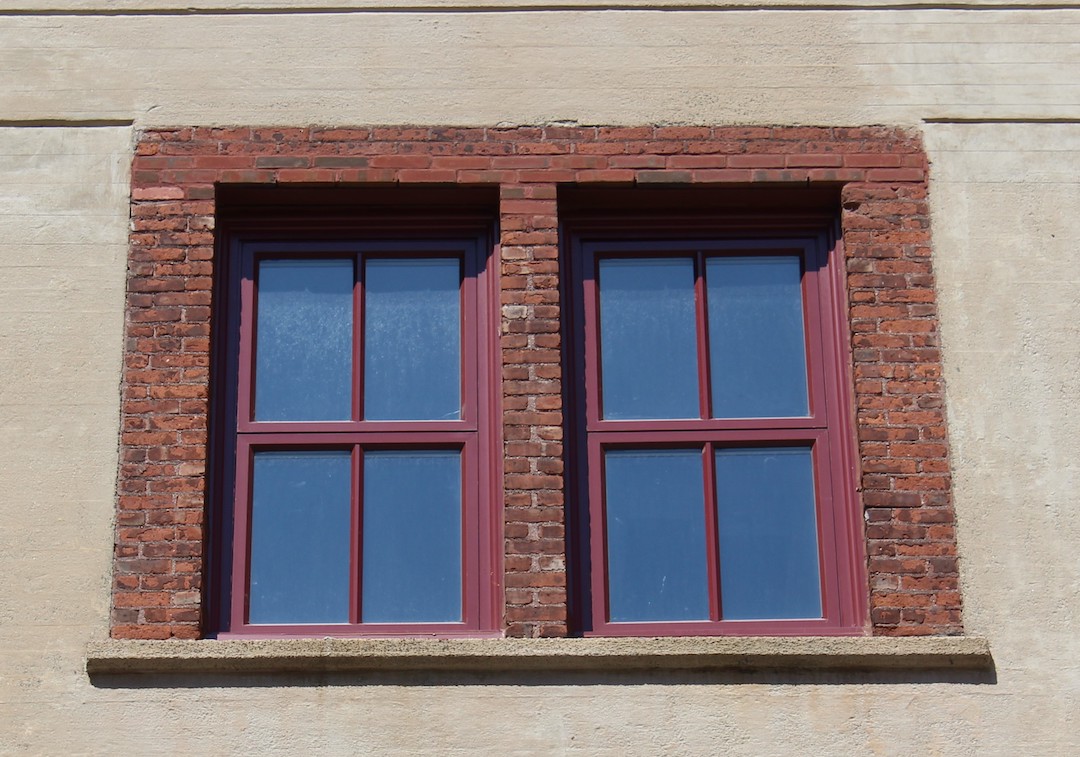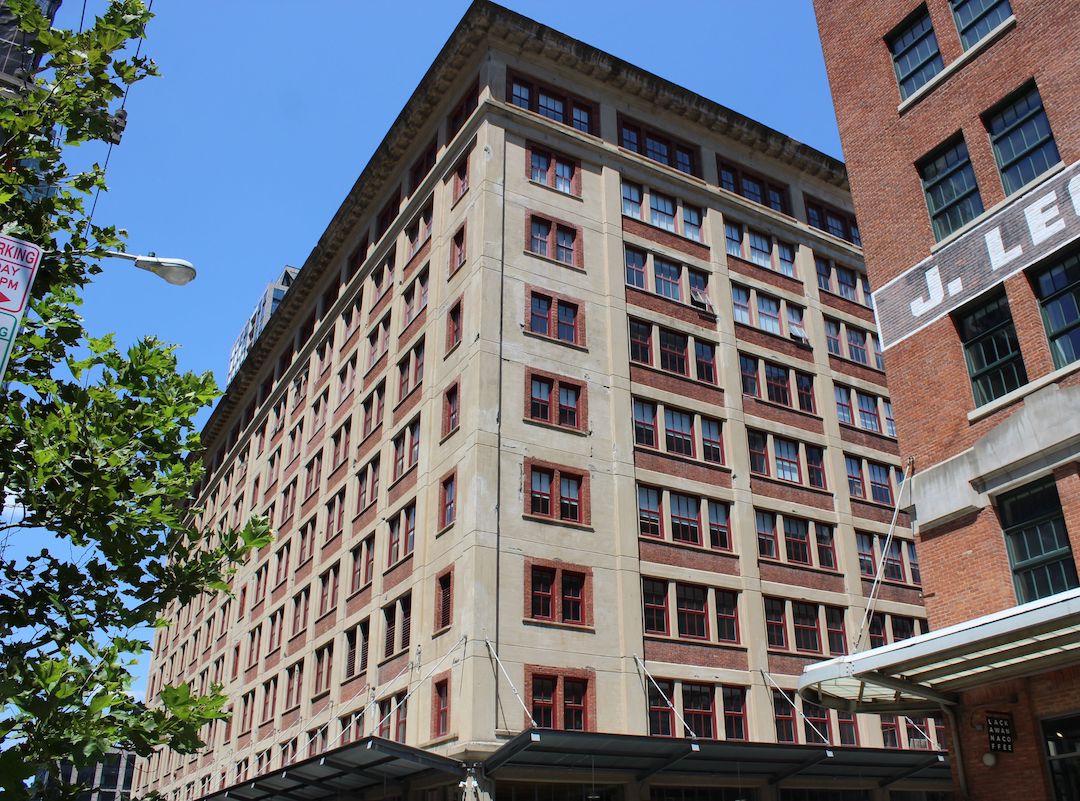Crystal Window & Door Systems products played a major role in the recent restoration and repurposing of a landmark building in Jersey City, N.J. The 10-story building at 150 Bay Street used 515 custom-modified Crystal windows on all four façades to retain the appearance and character of the 113-year-old historic structure.
The 150 Bay Street rehabilitation included the restoration of the brick and masonry façade, ornate roof cornice, and cantilevered cable-supported loading dock shed roofs. Replacing the antiquated wood windows with a modern window system that retained the historic characteristics of the building added to the challenge.
Crystal Window & Door Systems worked closely with the fenestration installer, BlueSky Windows, and the project architect and general contractor. Crystal fast-tracked the concept of, design, and fabrication of a custom window system solution which met and exceeded the project’s historic restoration requirements.
Custom-modified window system
The Crystal custom-modified window system replicates the original tall double-hung wood windows with a unique modern energy-efficient vertically stacked twin project-out awning aluminum window.
To truly deliver the project’s historic look, Crystal’s engineers used the resources of the company’s aluminum supply partners and its extrusion subsidiary to custom produce a special-frame variant of a standard projected window product, fabricate a 3-piece simulated divided light system, and replicate a historic-look sash with a 1-inch putty-line-look glazing bead as well as historic panning.
The 150 Bay Street project used Crystal’s Series 8620 Project-Out Awning windows. The Series 8620 windows were ordered in 2-lite vertically-stacked configurations and custom modified to suit the historic appearance requirements of the renovation project. With the building’s 14-foot-high loft ceiling heights, the windows are all very tall, the largest being 58½ inches wide by 81 inches high.
The Crystal Series 8620 is a top-of-the-line 3¼-inch thermal-broken frame awning window with an AW-PG80 rating. The energy-efficient window features 1” dual-pane insulated glass with warm edge spacer and argon filling, as well as two rows of bulb weatherstripping around the sash perimeter.
The Crystal Series 8620 offers cam lock handles and four-bar HS/SS friction hinges to hold the sash in open positions. Optional sash opening limit devices were also specified.

To meet the project’s historic specifications, Crystal made several custom modifications to the Series 8620. To emulate the building’s original wood windows, Crystal designed custom sash and frame extrusions, which its supply partners fabricated.
While the 2-lite stacked awning windows replicate the horizontal meeting rail of the original double-hung windows, each sash used special custom vertical simulated divided light (SDL) components to improve the historic aesthetics. The SDL components consisted of a standard colonial ⅝” between-the-glass grid with aligned 1¾-inch raised trapezoidal profile colonial tape-on aluminum grids affixed to the interior and exterior glass.
The project also required Crystal to produce several custom aluminum historic panning extrusions for the head, jamb, and sill of the window openings. All the Crystal windows, panning, grid components, and visible installation accessories were finished in a two-tone special Arroyo Red exterior and white interior to enhance the historic appearance of the building.
Key players for the Bay Street renovation project included fenestration installer BlueSky Windows and architect Fifield-Piaker-Elman Architects, both of New York City.
Three floors devoted to student housing
The repurposed 10-story, 203,000-square-foot building at 150 Bay Street now features ground-floor retail, art studio workspaces on the second floor, and business offices on the third floor. The upper floors are residential loft apartments, with three floors used by Nyack College as student residences, and luxury penthouses on the top floor.
Besides its historic, retro exterior, the building has many new features such as a roof patio, lounge areas, and a fitness center. The building is located in the Powerhouse Arts District, a lively artisan and business enclave in Jersey City.
Part of the resurgence of the state’s second largest city of over 250,000 residents, the Powerhouse Arts District has cobblestone streets, rehabbed former industrial buildings, shops, coffee houses, restaurants, bars, outdoor streetscape spaces, and art galleries.
Related Stories
| Feb 10, 2011
7 Things to Know About Impact Glazing and Fire-rated Glass
Back-to-basics answers to seven common questions about impact glazing and fire-rated glass.
| Jan 21, 2011
Music festival’s new home showcases scenic setting
Epstein Joslin Architects, Cambridge, Mass., designed the Shalin Liu Performance Center in Rockport, Mass., to showcase the Rockport Chamber Music Festival, as well at the site’s ocean views.
| Nov 16, 2010
NFRC approves technical procedures for attachment product ratings
The NFRC Board of Directors has approved technical procedures for the development of U-factor, solar heat gain coefficient (SHGC), and visible transmittance (VT) ratings for co-planar interior and exterior attachment products. The new procedures, approved by unanimous voice vote last week at NFRC’s Fall Membership Meeting in San Francisco, will add co-planar attachments such as blinds and shades to the group’s existing portfolio of windows, doors, skylights, curtain walls, and window film.
| Nov 3, 2010
First of three green labs opens at Iowa State University
Designed by ZGF Architects, in association with OPN Architects, the Biorenewable Research Laboratory on the Ames campus of Iowa State University is the first of three projects completed as part of the school’s Biorenewables Complex. The 71,800-sf LEED Gold project is one of three wings that will make up the 210,000-sf complex.
| Nov 3, 2010
Public works complex gets eco-friendly addition
The renovation and expansion of the public works operations facility in Wilmette, Ill., including a 5,000-sf addition that houses administrative and engineering offices, locker rooms, and a lunch room/meeting room, is seeking LEED Gold certification.
| Nov 3, 2010
Sailing center sets course for energy efficiency, sustainability
The Milwaukee (Wis.) Community Sailing Center’s new facility on Lake Michigan counts a geothermal heating and cooling system among its sustainable features. The facility was designed for the nonprofit instructional sailing organization with energy efficiency and low operating costs in mind.
| Nov 2, 2010
Cypress Siding Helps Nature Center Look its Part
The Trinity River Audubon Center, which sits within a 6,000-acre forest just outside Dallas, utilizes sustainable materials that help the $12.5 million nature center fit its wooded setting and put it on a path to earning LEED Gold.
| Oct 13, 2010
Prefab Trailblazer
The $137 million, 12-story, 500,000-sf Miami Valley Hospital cardiac center, Dayton, Ohio, is the first major hospital project in the U.S. to have made extensive use of prefabricated components in its design and construction.
| Oct 13, 2010
Hospital tower gets modern makeover
The Wellmont Holston Valley Medical Center in Kingsport, Tenn., expanded its D unit, a project that includes a 243,443-sf addition with a 12-room operating suite, a 36-bed intensive care unit, and an enlarged emergency department.
| Oct 13, 2010
Modern office design accentuates skyline views
Intercontinental|Exchange, a Chicago-based financial firm, hired design/engineering firm Epstein to create a modern, new 31st-floor headquarters.
















